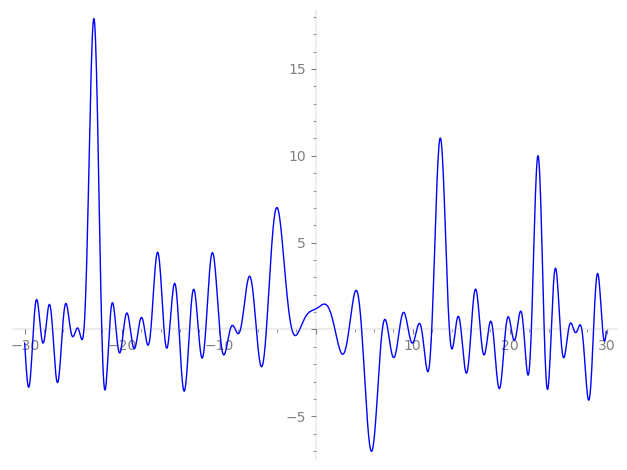| L(s) = 1 | + (−1.40 + 0.171i)2-s + (1.44 − 1.44i)3-s + (1.94 − 0.481i)4-s + (0.849 − 2.06i)5-s + (−1.77 + 2.27i)6-s + (3.60 + 3.60i)7-s + (−2.64 + 1.00i)8-s − 1.16i·9-s + (−0.837 + 3.04i)10-s − i·11-s + (2.10 − 3.49i)12-s + (−2.27 − 2.27i)13-s + (−5.67 − 4.44i)14-s + (−1.76 − 4.21i)15-s + (3.53 − 1.86i)16-s + (−3.21 + 3.21i)17-s + ⋯ |
| L(s) = 1 | + (−0.992 + 0.121i)2-s + (0.833 − 0.833i)3-s + (0.970 − 0.240i)4-s + (0.379 − 0.925i)5-s + (−0.726 + 0.928i)6-s + (1.36 + 1.36i)7-s + (−0.934 + 0.356i)8-s − 0.388i·9-s + (−0.264 + 0.964i)10-s − 0.301i·11-s + (0.608 − 1.00i)12-s + (−0.630 − 0.630i)13-s + (−1.51 − 1.18i)14-s + (−0.454 − 1.08i)15-s + (0.884 − 0.467i)16-s + (−0.780 + 0.780i)17-s + ⋯ |
Λ(s)=(=(220s/2ΓC(s)L(s)(0.764+0.644i)Λ(2−s)
Λ(s)=(=(220s/2ΓC(s+1/2)L(s)(0.764+0.644i)Λ(1−s)
| Degree: |
2 |
| Conductor: |
220
= 22⋅5⋅11
|
| Sign: |
0.764+0.644i
|
| Analytic conductor: |
1.75670 |
| Root analytic conductor: |
1.32540 |
| Motivic weight: |
1 |
| Rational: |
no |
| Arithmetic: |
yes |
| Character: |
χ220(23,⋅)
|
| Primitive: |
yes
|
| Self-dual: |
no
|
| Analytic rank: |
0
|
| Selberg data: |
(2, 220, ( :1/2), 0.764+0.644i)
|
Particular Values
| L(1) |
≈ |
1.11131−0.405586i |
| L(21) |
≈ |
1.11131−0.405586i |
| L(23) |
|
not available |
| L(1) |
|
not available |
L(s)=p∏Fp(p−s)−1 | p | Fp(T) |
|---|
| bad | 2 | 1+(1.40−0.171i)T |
| 5 | 1+(−0.849+2.06i)T |
| 11 | 1+iT |
| good | 3 | 1+(−1.44+1.44i)T−3iT2 |
| 7 | 1+(−3.60−3.60i)T+7iT2 |
| 13 | 1+(2.27+2.27i)T+13iT2 |
| 17 | 1+(3.21−3.21i)T−17iT2 |
| 19 | 1−1.17T+19T2 |
| 23 | 1+(1.72−1.72i)T−23iT2 |
| 29 | 1+8.70iT−29T2 |
| 31 | 1+2.23iT−31T2 |
| 37 | 1+(4.21−4.21i)T−37iT2 |
| 41 | 1+1.59T+41T2 |
| 43 | 1+(4.09−4.09i)T−43iT2 |
| 47 | 1+(0.691+0.691i)T+47iT2 |
| 53 | 1+(3.07+3.07i)T+53iT2 |
| 59 | 1−3.06T+59T2 |
| 61 | 1+3.44T+61T2 |
| 67 | 1+(4.51+4.51i)T+67iT2 |
| 71 | 1−10.0iT−71T2 |
| 73 | 1+(−6.84−6.84i)T+73iT2 |
| 79 | 1+0.973T+79T2 |
| 83 | 1+(−0.453+0.453i)T−83iT2 |
| 89 | 1−4.23iT−89T2 |
| 97 | 1+(−7.14+7.14i)T−97iT2 |
| show more | |
| show less | |
L(s)=p∏ j=1∏2(1−αj,pp−s)−1
Imaginary part of the first few zeros on the critical line
−12.09750564678114081663752787049, −11.33730367539888552506620928178, −9.897425308822187993135215382115, −8.822850224362638479310476345185, −8.283423179890846360680478641926, −7.75583483743621505364820571061, −6.11667864919122207599991818756, −5.08569246358643107240420504906, −2.45350545364561619093950087858, −1.65613977053951714189558617124,
1.98255276241600182583495254897, 3.42911804521163661870955677299, 4.73177467559011348929950656704, 6.86753902431564649805475067607, 7.43376770045736862604293991387, 8.627904554195719399823574697970, 9.540972197050607005236152036261, 10.42340688957783436198945029180, 10.91690435608967953768111848301, 11.95789803317719244699753721010

